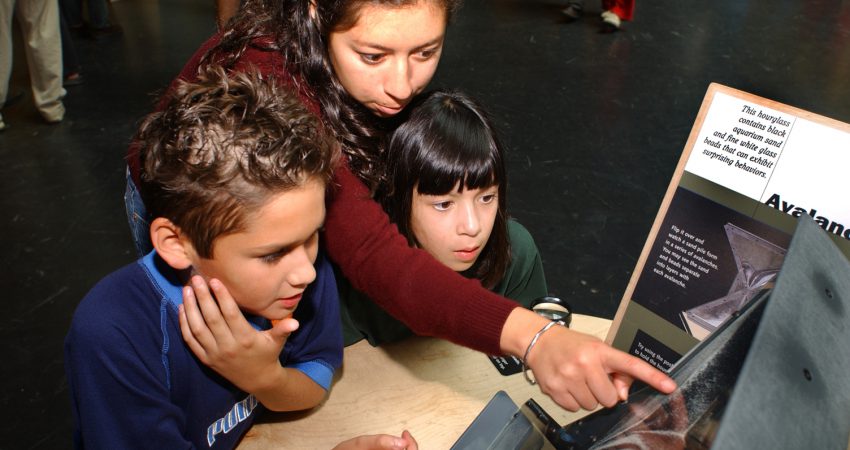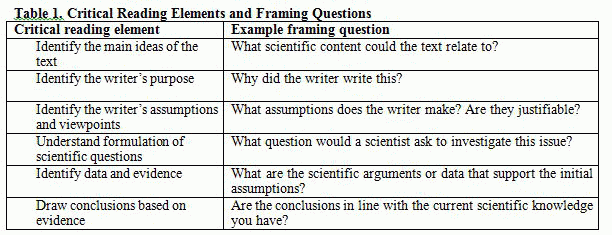
By Catarina Filipe Correia and Heather King - November 2015
PAPER CITATION
Oliveras, B., Márquez, C., & Sanmartí, N. (2013). The use of newspaper articles as a tool to develop critical thinking in science classes. International Journal of Science Education, 35(6), 885–905
Developing the ability to read science-themed media reports critically is of great importance, given the media’s pervasive and powerful influence on people’s beliefs and behaviours (Norris, Phillips, & Korpan, 2003). This paper conceptualizes critical reading as an active process of meaning making in which readers adopt a critical stance by comparing the information in the text with their prior knowledge. To measure the extent of science critical reading, Oliveras and colleagues identified six elements of critical reading (see Table 1), based on prior studies by Bartz (2002) and Paul and Elder (2006).
Research Design
Oliveras and colleagues divided 61 15- and 16-year-old students in Catalonia (Spain) into two groups. Each group was given one of two science-related newspaper articles and matching classroom activities.
- One article concerned the difficulty of removing graffiti from glass surfaces due to the fact that acid is mixed with graffiti paints. Students were expected to challenge the content based on their prior knowledge that most acids do not react with glass.
- The other article discussed innovative swimwear designed to improve swimmers’ performance. Students were challenged to devise experiments to test the article’s arguments.
The classroom activities lasted five hours and mostly consisted of collaborative group work, supplemented by whole-group discussions and Internet research. The activities were framed by a series of questions designed to elicit prior knowledge and encourage specific elements of reasoning. Example questions are outlined in Table 1.

Research Findings
An analysis of students’ responses to the questions during the activities indicated that students had the most difficulty in applying two elements: the identification of the writer’s purpose and the identification of data and evidence.
Students’ responses at the beginning of the activity suggested that most students believed that the purpose of newspaper reports is to inform people in a neutral and unbiased manner. The students also perceived journalists to be informed and qualified to discuss science topics. Finally, the students seemed to think that the mere inclusion of a scientific term, such as acid, signaled that the article had a scientific basis.
However, an analysis of students’ written work at the end of the activity revealed that many students were capable of drawing conclusions and questioning arguments given the evidence available. The authors suggest that the framing questions encouraged students to think about the scientific model implicit in the text and to compare the text’s viewpoints with additional information gathered from the Internet.
Theoretical Basis
According to Olson (1994), reading is an active process of construction of meaning based on the text. The reader consciously makes three different worlds interact: the world of the reader, made up of his or her knowledge, beliefs, or emotions; the world on paper defined in the text; and the outside world. This perspective emphasizes that, in order to read and make sense of science-related newspaper articles, students must activate the scientific knowledge they have learned at school or at home.
For their analytical framework, Oliveras and colleagues built on the work of Bartz (2002) and Paul and Elder (2006). Bartz’s (2002) CRITIC framework prompts students to consider the nature of the Claim, the Role of the claim, the Information backing the claim, the Test for assessing the claim, whether the test is Independent, and finally the nature and scientific consistency of the Causal explanation.
Paul and Elder’s (2006) work relates to the nature of reasoning. They note that all reasoning is expressed through and shaped by concepts and ideas, has a purpose, is done from some point of view, is based on assumptions, is an attempt to answer some question, is based on information, and contains inferences or interpretations by which people draw conclusions and give meaning to data. Oliveras and colleagues combined the principles of Paul and Elder with the prompts of Bartz to identify their six elements of critical reading.
Implications for Practice
The design of this study did not include pre- and post-instruction testing or a control population. Nevertheless, the results suggest that a structured framework of questions can help students develop a critical stance toward science-related articles in the media.
In addition, and perhaps more significantly, the authors suggest that activities designed to develop critical reading skills may help students to apply their science learning to situations such as they read in newspaper reports. Furthermore, learning how to formulate scientific questions to verify information in a text helps students develop key skills for science inquiry.
Finally, the authors believe that carrying out most class activities in small groups may have enhanced students’ abilities to analyze and reflect on the texts. Although this suggestion about the effectiveness of collaborative learning supports prior studies (see Alexander, 2008), further research to test this claim is needed.
References
Alexander, R. J. (2008). Towards dialogic reasoning: Rethinking classroom talk. York, UK: Dialogos.
Bartz, W. R. (2002). Teaching skepticism via the CRITIC acronym and the critical inquirer. Skeptical Inquirer, 26(5), 42–44.
Norris, S. P., Phillips, L. M., & Korpan, C. A. (2003). University students' interpretation of media reports of science and its relationship to background knowledge, interest, and reading difficulty. Public Understanding of Science,12(2), 123–145.
Olson, D. R. (1994). The world on paper. Cambridge, UK: Cambridge University Press
Paul, R., & Elder, L. (2006). The miniature guide to critical thinking and tools. Foundations for critical thinking. Retrieved May 20, 2010, from http://www.criticalthinking.org




